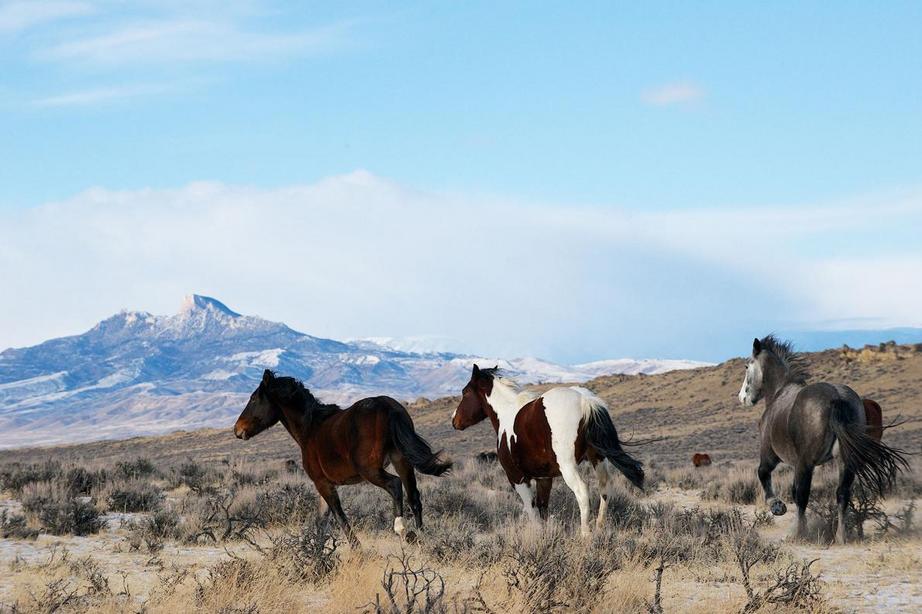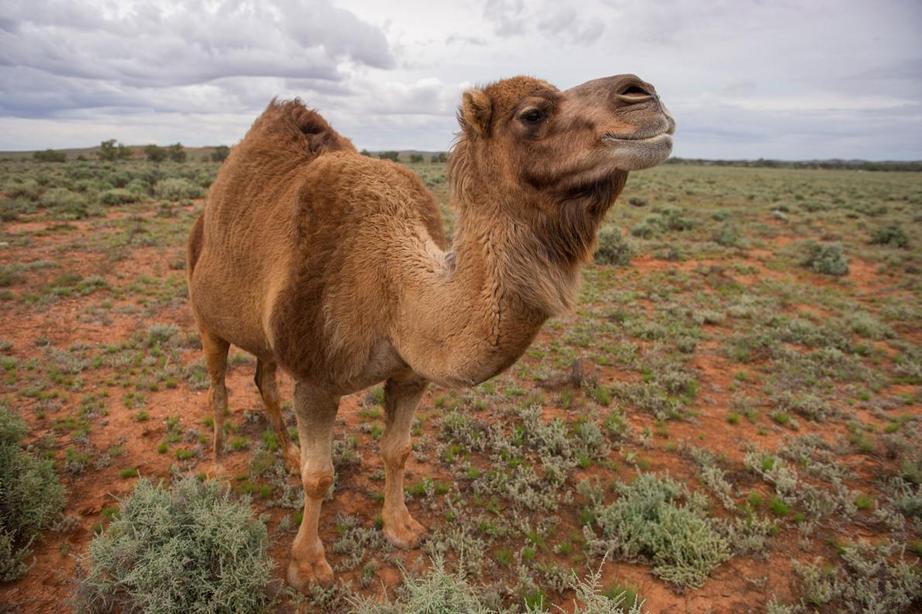These giant invasive beasts may actually be good for the planet
Feral horses or camels may not "belong" where we put them, a new study says, but they're keeping the species wild and helping the ecosystem.
Wild horses grazing on the Western range, dromedary camels roaming the Australian outback, hippos lounging in Colombian lakes—they all have two things in common: They’re very large herbivores, and they’re on the “wrong” continent. They were imported from their native range by people—in the case of the hippos, by the now-deceased drug lord Pablo Escobar, whose private zoo the beasts escaped from.
The conventional view among ecologists is that these species and other expatriate herbivores are an ecological problem. A new study takes issue with that, arguing that we should welcome them in their new ranges. According to the authors, out-of-place beasts are either replacing grazing animals that humans drove extinct thousands of years ago, or preserving their own species from extinction, or both.
Of the 76 herbivores in the world that weigh more than 100 kilograms (220 pounds), 22 have substantial populations outside their native ranges, according to ecologist Erick Lundgren of Arizona State University and his colleagues. Of those 22, half are threatened or extinct in their native ranges.
Some of the new populations are feral, that is, they’re wild now but are descended from domesticated versions of extinct species. The aurochs that humans once painted on caves, for example, and later domesticated into modern cattle, is long since extinct—but feral cattle run wild from Hawaii to Hong Kong.
Though every population has its own story—Pablo Escobar used his hippos to show off—there are common themes. “Either they are beasts of burden that became replaced by automobiles, or they were introduced for hunting for meat or sport,” Lundgren says.
Drug Kingpin Pablo Escobar’s Hippos Are Alive and Well
Video can be accessed at source link below
The question now is how to think and what to do about them. Lundgren and co-author Arian Wallach, an ecologist at the University of Technology Sydney in Australia, say these animals are often bringing grazing back to landscapes where it has been missing. By grazing tree seedlings, large herbivores keep grasslands from turning into forest and reduce fire risk. By grazing in one place and pooping in another, they move nutrients around.
In Arizona Lundgren has even watched wild burros—whose ancestors hail from North Africa—dig water holes that are then used by coyotes, javelinas, bighorn sheep, and plants. But to a lot of Arizonans these days, the burros are pests that amble around town as if they own the place, and wreck cars by allowing themselves to get hit.
They Can’t Go Home Again
Many conservationists have argued that such wayward animals should be “put back” in their native habitats. But that often isn’t possible, Wallach says. The one-humped dromedary camel is an example.
“There is a reason why these animals went extinct in the Middle East in the first place,” she says. Wild camels were presumably hunted and domesticated out of existence, and today there’s no obvious place in the Middle East or North Africa where they’d be safe for a massive reintroduction effort. Besides, Wallach points out, although we tend to think that the dromedary “belongs” in the Middle East—because that is where humans first encountered and domesticated it—the species actually evolved millions of years earlier in North America.
Today, Wallach says, “camels are best suited to Australia,” where they were introduced in the 19th century, and where there are now some 300,000 dromedaries wandering in the desert. Part of the reason she and her colleagues conducted their survey was to get people to realize that these non-native populations are often large and ecologically influential.
Wallach got the idea while looking at a map created by co-author William Ripple, an ecologist at Oregon State University in Corvallis. The map showed where large herbivores live on Earth, but Australia was completely empty—despite the fact that, in addition to the world’s only population of wild dromedaries, it currently hosts seven other introduced species of large herbivore, including donkeys, water buffalo, horses, the endangered banteng from Southeast Asia, and the vulnerable sambar deer, from India.
Because they aren’t native, they weren’t on Ripple’s original map. This selective vision is widespread in ecology, and in practice it means that little is known about these populations. Even now, with the study complete, Lundgren is hearing about new populations with some regularity. “I just found a new species that we missed,” he says. “Giant eland in Cuba. There’s like 1,000.” This uncommonly beautiful antelope is vulnerable to extinction in its native Africa.
“These animals exist,” says Lundgren. “For many of them the introduced home is the home they know more than anywhere else. We would spend a great deal of energy and time killing these animals if we were to try to go back to some pure historic baseline.” Instead, he thinks it better to “open our eyes to a wonder that we so often ignore and celebrate these animals.”
Celebrate Camels? Please.
Other ecologists are not yet breaking out the champagne. Daniel Simberloff of the University of Tennessee studies the impact of non-native species on ecosystems, and he says Lundgren and his colleagues have unfairly stacked the deck, reporting only the positive impacts of the invasive herbivores and ignoring the problems they cause.
“Camels, for Christ’s sake,” Simberloff says. “There is an entire book and many papers about the many inimical impacts—ecological as well as economic and social, of feral camels.” Indeed, studies suggest that the desert wanderers damage and foul water holes and springs, including those that have cultural significance to Aboriginal people. The taciturn beasts have also locally wiped out tasty plants such as the quandong, a delicious fruit in the sandalwood family.
Given the extinction of wild camels in Arabia, Simberloff says, a carefully managed conservation herd could be kept Down Under. But “they don’t have to roam over half of Australia.

Wild horses—these are in the McCullough Peaks Herd Management Area near Cody, Wyoming—are a contentious issue in the American West.
Photograph by Bob Smith, National Geographic Creative
Other researchers like the idea of taking another look at invasive populations, in theory. But they say the devil is—as always in ecology—in the details. Eric Beever, a United States Geological Survey ecologist based in Bozeman, Montana, says that while some grazing on a landscape might be great, too much can reduce the diversity of other flora and fauna, from small mammals to plants. Without predators keeping these out-of-place herbivores in check, species like wild horses can becomes a real problem in the American West.
“I love riding horses,” Beever says. “In a romantic sense it is a beautiful thing to watch them; from an ecologist’s perspective….” he trails off, then quotes ecologist Aldo Leopold. “One of the penalties of an ecological education,” Leopold once wrote, “is that one lives alone in a world of wounds. Much of the damage inflicted on land is quite invisible to laymen.” For Beever, the intensive grazing of wild horses—though it’s far outweighed by the impact of domestic cattle—is one such wound.
Wallach, who isn’t a layperson, doesn’t see it that way. The landscape that so many ecologists associate with natural health in western North America isn’t natural, she says. It was actually created by the extinction, starting more than 10,000 years ago, of the many large animals that lived in North America during the Pleistocene ice ages. Human hunters were the main culprit, and the result was a greener, woodsier world with less grazing in it.
“The concept of ‘overgrazing’ tells us about ourselves,” Wallach says. “When one says animals are overgrazing, one is really saying ‘I feel that this landscape has a grazing impact that I don’t like.’”
Next: Invasive Elephants?
Cornell ecologist Harry Greene, for one, is willing to go beyond celebrating the herbivores we’ve already introduced. He thinks we should consider introducing more, as proxies for the Pleistocene animals that went extinct.
North America used to host a lot of mammoths, and burros, wild horses, and cattle don’t exactly replace these enormous browsers. Elephants might, though—and Greene proposes we do an experiment to see how they would interact with a modern American ecosystem. “We have over 100 Asian elephants in the country now, and there is increasing sentiment to get them out of zoos,” he says. Why not create a controlled herd, behind fences, and study them?
Threatened by habitat loss and poaching in Africa and Asia, elephants might one day, in this view, find refuge in America. “If the only elephants left on earth were a North American herd that started with zoo animals, that would still be better than no elephants left on Earth at all,” Greene says.
For the rest of this article please go to source link below.
Video can be accessed at source link below.

